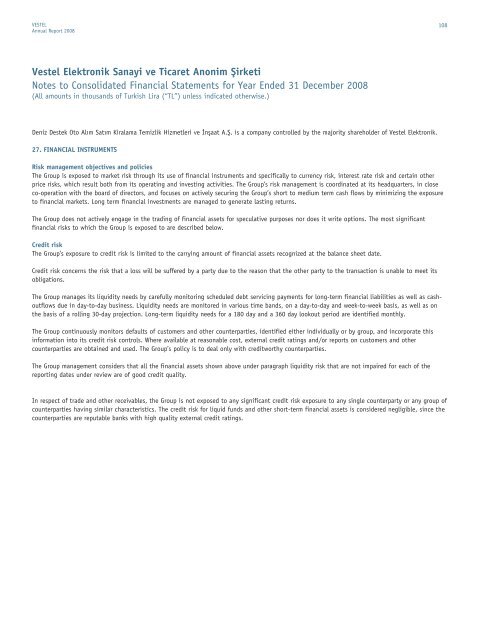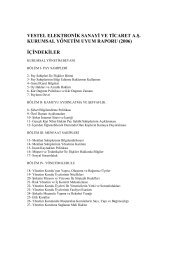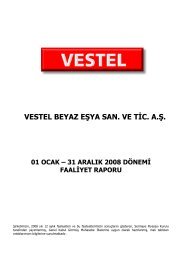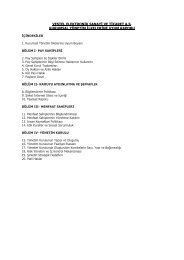Faaliyet Raporu 2008
Faaliyet Raporu 2008
Faaliyet Raporu 2008
Create successful ePaper yourself
Turn your PDF publications into a flip-book with our unique Google optimized e-Paper software.
VESTEL<br />
Annual Report <strong>2008</strong><br />
108<br />
Vestel Elektronik Sanayi ve Ticaret Anonim fiirketi<br />
Notes to Consolidated Financial Statements for Year Ended 31 December <strong>2008</strong><br />
(All amounts in thousands of Turkish Lira (“TL”) unless indicated otherwise.)<br />
Deniz Destek Oto Al›m Sat›m Kiralama Temizlik Hizmetleri ve ‹nflaat A.fi. is a company controlled by the majority shareholder of Vestel Elektronik.<br />
27. FINANCIAL INSTRUMENTS<br />
Risk management objectives and policies<br />
The Group is exposed to market risk through its use of financial instruments and specifically to currency risk, interest rate risk and certain other<br />
price risks, which result both from its operating and investing activities. The Group’s risk management is coordinated at its headquarters, in close<br />
co-operation with the board of directors, and focuses on actively securing the Group’s short to medium term cash flows by minimizing the exposure<br />
to financial markets. Long term financial investments are managed to generate lasting returns.<br />
The Group does not actively engage in the trading of financial assets for speculative purposes nor does it write options. The most significant<br />
financial risks to which the Group is exposed to are described below.<br />
Credit risk<br />
The Group’s exposure to credit risk is limited to the carrying amount of financial assets recognized at the balance sheet date.<br />
Credit risk concerns the risk that a loss will be suffered by a party due to the reason that the other party to the transaction is unable to meet its<br />
obligations.<br />
The Group manages its liquidity needs by carefully monitoring scheduled debt servicing payments for long-term financial liabilities as well as cashoutflows<br />
due in day-to-day business. Liquidity needs are monitored in various time bands, on a day-to-day and week-to-week basis, as well as on<br />
the basis of a rolling 30-day projection. Long-term liquidity needs for a 180 day and a 360 day lookout period are identified monthly.<br />
The Group continuously monitors defaults of customers and other counterparties, identified either individually or by group, and incorporate this<br />
information into its credit risk controls. Where available at reasonable cost, external credit ratings and/or reports on customers and other<br />
counterparties are obtained and used. The Group’s policy is to deal only with creditworthy counterparties.<br />
The Group management considers that all the financial assets shown above under paragraph liquidity risk that are not impaired for each of the<br />
reporting dates under review are of good credit quality.<br />
In respect of trade and other receivables, the Group is not exposed to any significant credit risk exposure to any single counterparty or any group of<br />
counterparties having similar characteristics. The credit risk for liquid funds and other short-term financial assets is considered negligible, since the<br />
counterparties are reputable banks with high quality external credit ratings.
















